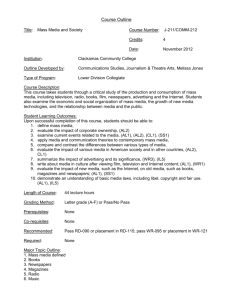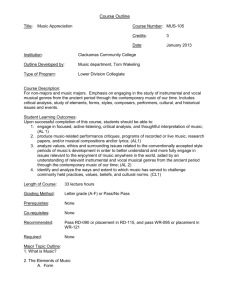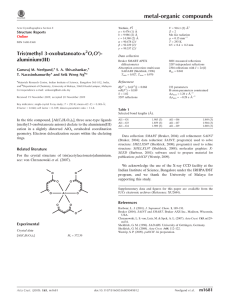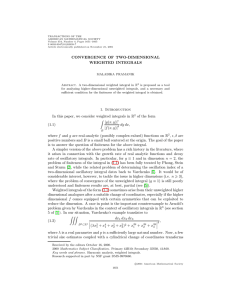Exercises to the lecture Basic Solid State Chemistry
advertisement
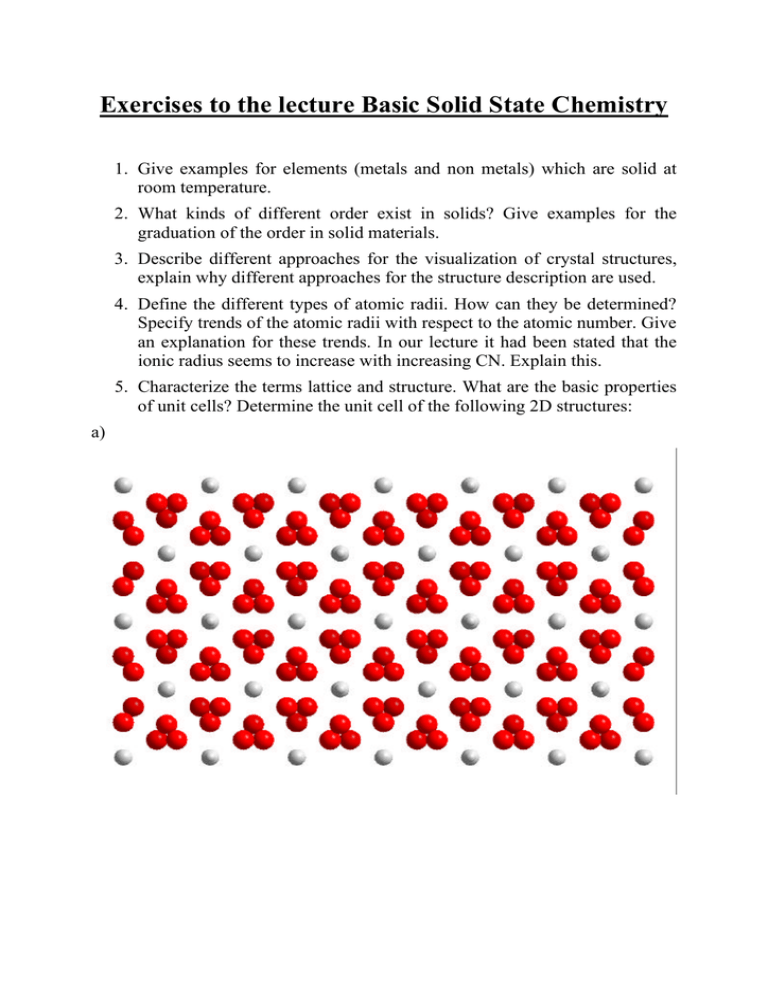
Exercises to the lecture Basic Solid State Chemistry 1. Give examples for elements (metals and non metals) which are solid at room temperature. 2. What kinds of different order exist in solids? Give examples for the graduation of the order in solid materials. 3. Describe different approaches for the visualization of crystal structures, explain why different approaches for the structure description are used. 4. Define the different types of atomic radii. How can they be determined? Specify trends of the atomic radii with respect to the atomic number. Give an explanation for these trends. In our lecture it had been stated that the ionic radius seems to increase with increasing CN. Explain this. 5. Characterize the terms lattice and structure. What are the basic properties of unit cells? Determine the unit cell of the following 2D structures: a) b) c) d) 6. What kinds of primitive unit cells occur in 3D space? Specify the restrictions of the crystal systems. Is it possible that… a) a ≠ b for a cubic unit cell, b) a = b = c for a monoclinic unit cell, c) a = b = c for a triclinic unit cell? Give reasons. 7. Sketch the following lattice vectors in a cubic unit cell: a) [121], b) [221], c) [-101], d) [-11-1], e) [-100], f) [-1-21]. Specify the origin of the cell and the coordinate system used in each case. 8. Sketch the following planes in a cubic unit cell: a) (221), b) (120), c) (111), d) (201), e) (-212), f) (-1-10). Specify the origin of the unit cell and the coordinate system used in each case. 9. Sketch the following atom positions in one cubic unit cell: 000; ½½0, ½½½. Specify the origin of the unit cell and the coordinate system, include all atoms in the sketch which are generated by unit cell translations. 10. Determine the fractional coordinates of a rock salt type structure. Use one triplet of coordinates for those atoms which are equivalent by unit cell translations. 11.How do we count atoms in unit cells? Why do we count atoms in unit cells? 12.Determine the number of atoms per hexagonal unit cell (specify the different counts of the atoms): a) atoms on all corner positions, b) atoms on the centers of all edges, c) atoms on all centers of the faces. 13.Explain the influence of the occupancy factor on the composition of a crystal. How is it possible to result in reduced occupancy factors applying standard X-ray diffraction experiments? 14.Calculate the composition of a Tb-compound using following crystal data: Atom Wyck. Occ. x y z Tb1 4j 1 0 ½ 0.08246(1) Tb2 8l 1 -½ 0.35053(1) 0.14389(1) Tb3 4j 1 0 1/2 Tb4 8l 0.5 0 0.14865(3) 0.06855(2) Tb5 2b 0.5 ½ 0 0 Tb6 4j 0.5 ½ 0 0.13399(1) Br1 2c 1 -½ ½ 0 Br2 8l 1 0 0.32905(4) 0.21705(2) Br3 8l 1 0 0.32854(4) 0.06904(3) Br4 4i 1 -½ ½ Br5 8l 1 -½ 0.16922(3) 0.14193(3) Br6 4h 1 ½ 0.17174(5) 0 Br7 4i 0.5 0 0 0.06818(17) B1 4i 1 -½ ½ 0.1435(4) B2 4i 0.5 0 0 0.075(2) 0.20345(1) 0.28702(3) 15.Describe the following terms: HCP, CCP, polytypes. Give examples for HCP and CCP arrangements in elements. How many different types of close packed arrangements exist in solids (give reasons for your answer)? 16.Imagine the following layer as an A-layer of a HCP arrangement. Mark the positions of OH and TH with respect to one possible B-layer position. 17.What are the common properties, what are the differences of HCP and CCP. 18.Calculate the space filling of CCP, BCC and primitive packing. 19.Specify the interconnection between the complexity of a metal structure and the temperature. 20.Sketch the position and number of OH and TH in a CCP arrangement. How are the octahedra of CCP and HCP interconnected? What are the consequences in filled structures of HCP and CCP? 21.Explain the term “optimum radius ratio”. Calculate the optimum radius ratio for a cubic and a tetrahedral coordination. 22.Use the second rule of Pauling for the following problems: a) A compound M4+X-4 with CN(M) = 6 has an unknown CN(X). Give reasonable values for CN(X). b) In the structure of garnet (Mg3Al2Si3O12) the CN(O) is 2(Mg) + 1(Al) + 1(Si). The CN of the cations are 4, 6 and 8. Assign the CN to the cations. c) The CN of O2- in the mineral spinel is 3(Al) + 1(Mg). Is the structure of spinel consistent with the second rule of Pauling? d) Determine the position of H in the structure of topas (CN (Al) = 6) using the following interatomic distances: O1 Si1 Al1 Al1 Si1 Al1 Al1 Al1 1.646 1.946 1.946 3.356 3.600 3.600 3.842 O2 Si1 Al1 Al1 Si1 Al1 Al1 1.665 1.940 1.940 3.262 3.375 3.375 O3 Si1 Al1 Al1 Al1 Si1 Al1 Al1 1.649 1.922 1.924 3.342 3.460 3.495 3.698 O4 Al1 Al1 Si1 Si1 Si1 Si1 Al1 1.833 1.834 3.160 3.262 3.296 3.319 3.405 23.Explain the third and forth rule of Pauling. 24.Describe the two frequently occurring variations of basic structure types. 25.Sketch the unit cells of the following basic structure types: a) rock salt, b) sphalerite, c) fluorite, d) Li3Bi. 26.Which structure type is depicted in the following polyhedral representation? 27.The structure of NbO is related to the rock salt type structure, describe this relation. 28.Sketch a projection of the unit cell of the following structure 29.In some textbooks, it is claimed that the Li3Bi is originating from BCC. Give reasons for that statement. 30. Describe the structure of corundum on the basis of a filled close packed structure. 31.Specify the different contributions to the total lattice energy of a crystal. What would happen, if we exclude all contributions to lattice energy except Coulomb interactions? What would happen, if the Madelung constant is smaller than one? Why is the melting point of MgO higher than the melting point of NaCl (both rock salt type structures)? 32.Calculate the first eight terms of the Madelung sum for a row of equally spaced atoms with alternating cations and anions. Calculate the first four terms of the Madelung sum for a rock salt type structure. 33.How can the sphalerite and wurzite type structures be derived from structures of carbon? 34. What is an important electronic prerequisite for the formation of diamond type structures. Give four examples of sphalerite type structures. 35.The structures of AgGaS2, AgIn3Te5 and AgIn5Se8 are related to the Sphalerite type. Give a rationalization for this statement. 36.Determine the stacking sequence of the following Sphalerite type structure. 37.Describe the structures of CdCl2 and CdI2. Give examples for an intercalation in layered structures. 38.Describe the structure of NiAs, sketch the environment of As. 39.Explain the following statement: ReO3 is the basic structure type of tungsten bronzes and perovskites. 40.Sketch and describe the unit cell of an undistorted perovskite. What kind of structural variations occur very frequently in the case of perovskite structures? What is the fundamental difference of cubic and hexagonal perovskites? 41.Determine the compositions and charges of the following SiO-structures of silicates. 42.What is the meaning of “inversion” in the domain of spinel structures? 43. Describe possible Si-O-substructures of the following silicate structures: a) Mg3Al2SiO4, b) Ca2Si2O7, c) BaTiSi3O9, d) Al2Be3Si6O18, e) CaMgSi2O6, f) Na8Al6Si6O24Cl2 44.What are the most important structural features of zeolites? Explain the general formula sum of zeolites. Give some examples for applications of zeolites. 45.Specify the prerequisites for the formation of solid solutions. Sketch the unit cells of the ordered structures of CuZn, CuAu and Cu3Au. 46.The compounds Ag5Zn8, Cu9Al4, Cu3Sn, Ag5Al3, Cu3Al and Cu3Sn are Hume-Rothery-phases. Which of those compounds are expected to crystallize in the same structure type? 47.Describe the structure of the Zintl phase NaTl. 48.Suggest models for the structures of the anions following the Zintl rule: Ca2Si, CaSi, CaSi2, Ba5Si3.


